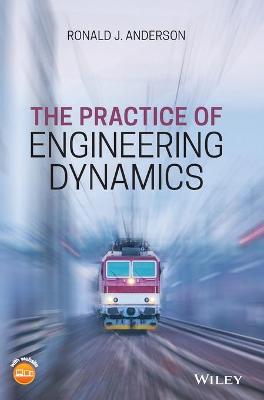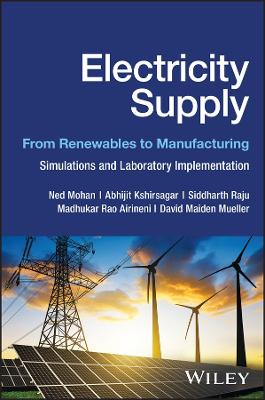Practice of Engineering Dynamics
 -15%
portes grátis
-15%
portes grátis
Practice of Engineering Dynamics
Anderson, Ronald J.
John Wiley & Sons Inc
06/2020
240
Dura
Inglês
9781119053705
15 a 20 dias
570
Descrição não disponível.
Preface xi
About the Companion Website xv
Part I Modeling: Deriving Equations of Motion 1
1 Kinematics 3
1.1 Derivatives of Vectors 3
1.2 Performing Kinematic Analysis 5
1.3 Two Dimensional Motion with Constant Length 6
1.4 Two Dimensional Motion with Variable Length 8
1.5 Three Dimensional Kinematics 10
1.6 Absolute Angular Velocity and Acceleration 13
1.7 The General Acceleration Expression 14
Exercises 16
2 Newton's Equations of Motion 19
2.1 The Study of Motion 19
2.2 Newton's Laws 19
2.3 Newton's Second Law for a Particle 20
2.4 Deriving Equations of Motion for Particles 21
2.5 Working with Rigid Bodies 25
2.6 Using F = ma in the Rigid Body Force Balance 26
2.7 Using F = dG/dt in the Rigid Body Force Balance 28
2.8 Moment Balance for a Rigid Body 30
2.9 The Angular Momentum Vector - HO 33
2.10 A Physical Interpretation of Moments and Products of Inertia 36
2.11 Euler's Moment Equations 40
2.12 Throwing a Spiral 41
2.13 A Two Body System 42
2.14 Gyroscopic Motion 48
Exercises 52
3 Lagrange's Equations of Motion 55
3.1 An Example to Start 55
3.2 Lagrange's Equation for a Single Particle 58
3.3 Generalized Forces 62
3.4 Generalized Forces as Derivatives of Potential Energy 64
3.5 Dampers - Rayleigh's Dissipation Function 65
3.6 Kinetic Energy of a Free Rigid Body 67
3.7 A Two Dimensional Example using Lagrange's Equation 70
3.7.1 The Kinetic Energy 70
3.7.2 The Potential Energy 71
3.7.3 The ?? Equation 72
3.7.4 The ?? Equation 73
3.8 Standard Form of the Equations of Motion 73
Exercises 74
Part II Simulation: Using the Equations of Motion 77
4 Equilibrium Solutions 79
4.1 The Simple Pendulum 79
4.2 Equilibrium with Two Degrees of Freedom 80
4.3 Equilibrium with Steady Motion 81
4.4 The General Equilibrium Solution 84
Exercises 85
5 Stability 87
5.1 Analytical Stability 87
5.2 Linearization of Functions 92
5.3 Example: A System with Two Degrees of Freedom 95
5.4 Routh Stability Criterion 99
5.5 Standard Procedure for Stability Analysis 103
Exercises 105
6 Mode Shapes 107
6.1 Eigenvectors 107
6.2 Comparing Translational and Rotational Degrees of Freedom 111
6.3 Nodal Points in Mode Shapes 115
6.4 Mode Shapes with Damping 116
6.5 Modal Damping 118
Exercises 122
7 Frequency Domain Analysis 125
7.1 Modeling Frequency Response 125
7.2 Seismic Disturbances 132
7.3 Power Spectral Density 133
7.3.1 Units of the PSD 138
7.3.2 Simulation using the PSD 139
Exercises 143
8 Time Domain Solutions 145
8.1 Getting the Equations of Motion Ready for Time Domain Simulation 146
8.2 A Time Domain Example 147
8.3 Numerical Schemes for Solving the Equations of Motion 149
8.4 Euler Integration 149
8.5 An Example Using the Euler Integrator 151
8.6 The Central Difference Method: An (h2) Method 153
8.7 Variable Time Step Methods 155
8.8 Methods with Higher Order Truncation Error 157
8.9 The Structure of a Simulation Program 159
Exercises 163
Part III Working with Experimental Data 165
9 Experimental Data - Frequency Domain Analysis 167
9.1 Typical Test Data 167
9.2 Transforming to the Frequency Domain - The CFT 169
9.3 Transforming to the Frequency Domain - The DFT 172
9.4 Transforming to the Frequency Domain - A Faster DFT 174
9.5 Transforming to the Frequency Domain - The FFT 175
9.6 Transforming to the Frequency Domain - An Example 176
9.7 Sampling and Aliasing 179
9.8 Leakage and Windowing 184
9.9 Decimating Data 187
9.10 Averaging DFTs 189
Exercises 189
A Representative Dynamic Systems 193
A.1 System 1 193
A.2 System 2 193
A.3 System 3 194
A.4 System 4 194
A.5 System 5 195
A.6 System 6 195
A.7 System 7 196
A.8 System 8 197
A.9 System 9 197
A.10 System 10 198
A.11 System 11 198
A.12 System 12 199
A.13 System 13 200
A.14 System 14 200
A.15 System 15 201
A.16 System 16 201
A.17 System 17 202
A.18 System 18 202
A.19 System 19 203
A.20 System 20 203
A.21 System 21 204
A.22 System 22 204
A.23 System 23 205
B Moments and Products of Inertia 207
B.1 Moments of Inertia 207
B.2 Parallel Axis Theorem for Moments of Inertia 208
B.3 Parallel Axis Theorem for Products of Inertia 210
B.4 Moments of Inertia for Commonly Encountered Bodies 210
C Dimensions and Units 213
D Least Squares Curve Fitting 215
Index 219
About the Companion Website xv
Part I Modeling: Deriving Equations of Motion 1
1 Kinematics 3
1.1 Derivatives of Vectors 3
1.2 Performing Kinematic Analysis 5
1.3 Two Dimensional Motion with Constant Length 6
1.4 Two Dimensional Motion with Variable Length 8
1.5 Three Dimensional Kinematics 10
1.6 Absolute Angular Velocity and Acceleration 13
1.7 The General Acceleration Expression 14
Exercises 16
2 Newton's Equations of Motion 19
2.1 The Study of Motion 19
2.2 Newton's Laws 19
2.3 Newton's Second Law for a Particle 20
2.4 Deriving Equations of Motion for Particles 21
2.5 Working with Rigid Bodies 25
2.6 Using F = ma in the Rigid Body Force Balance 26
2.7 Using F = dG/dt in the Rigid Body Force Balance 28
2.8 Moment Balance for a Rigid Body 30
2.9 The Angular Momentum Vector - HO 33
2.10 A Physical Interpretation of Moments and Products of Inertia 36
2.11 Euler's Moment Equations 40
2.12 Throwing a Spiral 41
2.13 A Two Body System 42
2.14 Gyroscopic Motion 48
Exercises 52
3 Lagrange's Equations of Motion 55
3.1 An Example to Start 55
3.2 Lagrange's Equation for a Single Particle 58
3.3 Generalized Forces 62
3.4 Generalized Forces as Derivatives of Potential Energy 64
3.5 Dampers - Rayleigh's Dissipation Function 65
3.6 Kinetic Energy of a Free Rigid Body 67
3.7 A Two Dimensional Example using Lagrange's Equation 70
3.7.1 The Kinetic Energy 70
3.7.2 The Potential Energy 71
3.7.3 The ?? Equation 72
3.7.4 The ?? Equation 73
3.8 Standard Form of the Equations of Motion 73
Exercises 74
Part II Simulation: Using the Equations of Motion 77
4 Equilibrium Solutions 79
4.1 The Simple Pendulum 79
4.2 Equilibrium with Two Degrees of Freedom 80
4.3 Equilibrium with Steady Motion 81
4.4 The General Equilibrium Solution 84
Exercises 85
5 Stability 87
5.1 Analytical Stability 87
5.2 Linearization of Functions 92
5.3 Example: A System with Two Degrees of Freedom 95
5.4 Routh Stability Criterion 99
5.5 Standard Procedure for Stability Analysis 103
Exercises 105
6 Mode Shapes 107
6.1 Eigenvectors 107
6.2 Comparing Translational and Rotational Degrees of Freedom 111
6.3 Nodal Points in Mode Shapes 115
6.4 Mode Shapes with Damping 116
6.5 Modal Damping 118
Exercises 122
7 Frequency Domain Analysis 125
7.1 Modeling Frequency Response 125
7.2 Seismic Disturbances 132
7.3 Power Spectral Density 133
7.3.1 Units of the PSD 138
7.3.2 Simulation using the PSD 139
Exercises 143
8 Time Domain Solutions 145
8.1 Getting the Equations of Motion Ready for Time Domain Simulation 146
8.2 A Time Domain Example 147
8.3 Numerical Schemes for Solving the Equations of Motion 149
8.4 Euler Integration 149
8.5 An Example Using the Euler Integrator 151
8.6 The Central Difference Method: An (h2) Method 153
8.7 Variable Time Step Methods 155
8.8 Methods with Higher Order Truncation Error 157
8.9 The Structure of a Simulation Program 159
Exercises 163
Part III Working with Experimental Data 165
9 Experimental Data - Frequency Domain Analysis 167
9.1 Typical Test Data 167
9.2 Transforming to the Frequency Domain - The CFT 169
9.3 Transforming to the Frequency Domain - The DFT 172
9.4 Transforming to the Frequency Domain - A Faster DFT 174
9.5 Transforming to the Frequency Domain - The FFT 175
9.6 Transforming to the Frequency Domain - An Example 176
9.7 Sampling and Aliasing 179
9.8 Leakage and Windowing 184
9.9 Decimating Data 187
9.10 Averaging DFTs 189
Exercises 189
A Representative Dynamic Systems 193
A.1 System 1 193
A.2 System 2 193
A.3 System 3 194
A.4 System 4 194
A.5 System 5 195
A.6 System 6 195
A.7 System 7 196
A.8 System 8 197
A.9 System 9 197
A.10 System 10 198
A.11 System 11 198
A.12 System 12 199
A.13 System 13 200
A.14 System 14 200
A.15 System 15 201
A.16 System 16 201
A.17 System 17 202
A.18 System 18 202
A.19 System 19 203
A.20 System 20 203
A.21 System 21 204
A.22 System 22 204
A.23 System 23 205
B Moments and Products of Inertia 207
B.1 Moments of Inertia 207
B.2 Parallel Axis Theorem for Moments of Inertia 208
B.3 Parallel Axis Theorem for Products of Inertia 210
B.4 Moments of Inertia for Commonly Encountered Bodies 210
C Dimensions and Units 213
D Least Squares Curve Fitting 215
Index 219
Este título pertence ao(s) assunto(s) indicados(s). Para ver outros títulos clique no assunto desejado.
Engineering Dynamics; textbook; systematic; dynamic analysis; mechanical systems; equilibrium; frequency analysis; experimental data; Modelling; Simulation; Equations of Motion; Experimental Frequency Domain Analysis
Preface xi
About the Companion Website xv
Part I Modeling: Deriving Equations of Motion 1
1 Kinematics 3
1.1 Derivatives of Vectors 3
1.2 Performing Kinematic Analysis 5
1.3 Two Dimensional Motion with Constant Length 6
1.4 Two Dimensional Motion with Variable Length 8
1.5 Three Dimensional Kinematics 10
1.6 Absolute Angular Velocity and Acceleration 13
1.7 The General Acceleration Expression 14
Exercises 16
2 Newton's Equations of Motion 19
2.1 The Study of Motion 19
2.2 Newton's Laws 19
2.3 Newton's Second Law for a Particle 20
2.4 Deriving Equations of Motion for Particles 21
2.5 Working with Rigid Bodies 25
2.6 Using F = ma in the Rigid Body Force Balance 26
2.7 Using F = dG/dt in the Rigid Body Force Balance 28
2.8 Moment Balance for a Rigid Body 30
2.9 The Angular Momentum Vector - HO 33
2.10 A Physical Interpretation of Moments and Products of Inertia 36
2.11 Euler's Moment Equations 40
2.12 Throwing a Spiral 41
2.13 A Two Body System 42
2.14 Gyroscopic Motion 48
Exercises 52
3 Lagrange's Equations of Motion 55
3.1 An Example to Start 55
3.2 Lagrange's Equation for a Single Particle 58
3.3 Generalized Forces 62
3.4 Generalized Forces as Derivatives of Potential Energy 64
3.5 Dampers - Rayleigh's Dissipation Function 65
3.6 Kinetic Energy of a Free Rigid Body 67
3.7 A Two Dimensional Example using Lagrange's Equation 70
3.7.1 The Kinetic Energy 70
3.7.2 The Potential Energy 71
3.7.3 The ?? Equation 72
3.7.4 The ?? Equation 73
3.8 Standard Form of the Equations of Motion 73
Exercises 74
Part II Simulation: Using the Equations of Motion 77
4 Equilibrium Solutions 79
4.1 The Simple Pendulum 79
4.2 Equilibrium with Two Degrees of Freedom 80
4.3 Equilibrium with Steady Motion 81
4.4 The General Equilibrium Solution 84
Exercises 85
5 Stability 87
5.1 Analytical Stability 87
5.2 Linearization of Functions 92
5.3 Example: A System with Two Degrees of Freedom 95
5.4 Routh Stability Criterion 99
5.5 Standard Procedure for Stability Analysis 103
Exercises 105
6 Mode Shapes 107
6.1 Eigenvectors 107
6.2 Comparing Translational and Rotational Degrees of Freedom 111
6.3 Nodal Points in Mode Shapes 115
6.4 Mode Shapes with Damping 116
6.5 Modal Damping 118
Exercises 122
7 Frequency Domain Analysis 125
7.1 Modeling Frequency Response 125
7.2 Seismic Disturbances 132
7.3 Power Spectral Density 133
7.3.1 Units of the PSD 138
7.3.2 Simulation using the PSD 139
Exercises 143
8 Time Domain Solutions 145
8.1 Getting the Equations of Motion Ready for Time Domain Simulation 146
8.2 A Time Domain Example 147
8.3 Numerical Schemes for Solving the Equations of Motion 149
8.4 Euler Integration 149
8.5 An Example Using the Euler Integrator 151
8.6 The Central Difference Method: An (h2) Method 153
8.7 Variable Time Step Methods 155
8.8 Methods with Higher Order Truncation Error 157
8.9 The Structure of a Simulation Program 159
Exercises 163
Part III Working with Experimental Data 165
9 Experimental Data - Frequency Domain Analysis 167
9.1 Typical Test Data 167
9.2 Transforming to the Frequency Domain - The CFT 169
9.3 Transforming to the Frequency Domain - The DFT 172
9.4 Transforming to the Frequency Domain - A Faster DFT 174
9.5 Transforming to the Frequency Domain - The FFT 175
9.6 Transforming to the Frequency Domain - An Example 176
9.7 Sampling and Aliasing 179
9.8 Leakage and Windowing 184
9.9 Decimating Data 187
9.10 Averaging DFTs 189
Exercises 189
A Representative Dynamic Systems 193
A.1 System 1 193
A.2 System 2 193
A.3 System 3 194
A.4 System 4 194
A.5 System 5 195
A.6 System 6 195
A.7 System 7 196
A.8 System 8 197
A.9 System 9 197
A.10 System 10 198
A.11 System 11 198
A.12 System 12 199
A.13 System 13 200
A.14 System 14 200
A.15 System 15 201
A.16 System 16 201
A.17 System 17 202
A.18 System 18 202
A.19 System 19 203
A.20 System 20 203
A.21 System 21 204
A.22 System 22 204
A.23 System 23 205
B Moments and Products of Inertia 207
B.1 Moments of Inertia 207
B.2 Parallel Axis Theorem for Moments of Inertia 208
B.3 Parallel Axis Theorem for Products of Inertia 210
B.4 Moments of Inertia for Commonly Encountered Bodies 210
C Dimensions and Units 213
D Least Squares Curve Fitting 215
Index 219
About the Companion Website xv
Part I Modeling: Deriving Equations of Motion 1
1 Kinematics 3
1.1 Derivatives of Vectors 3
1.2 Performing Kinematic Analysis 5
1.3 Two Dimensional Motion with Constant Length 6
1.4 Two Dimensional Motion with Variable Length 8
1.5 Three Dimensional Kinematics 10
1.6 Absolute Angular Velocity and Acceleration 13
1.7 The General Acceleration Expression 14
Exercises 16
2 Newton's Equations of Motion 19
2.1 The Study of Motion 19
2.2 Newton's Laws 19
2.3 Newton's Second Law for a Particle 20
2.4 Deriving Equations of Motion for Particles 21
2.5 Working with Rigid Bodies 25
2.6 Using F = ma in the Rigid Body Force Balance 26
2.7 Using F = dG/dt in the Rigid Body Force Balance 28
2.8 Moment Balance for a Rigid Body 30
2.9 The Angular Momentum Vector - HO 33
2.10 A Physical Interpretation of Moments and Products of Inertia 36
2.11 Euler's Moment Equations 40
2.12 Throwing a Spiral 41
2.13 A Two Body System 42
2.14 Gyroscopic Motion 48
Exercises 52
3 Lagrange's Equations of Motion 55
3.1 An Example to Start 55
3.2 Lagrange's Equation for a Single Particle 58
3.3 Generalized Forces 62
3.4 Generalized Forces as Derivatives of Potential Energy 64
3.5 Dampers - Rayleigh's Dissipation Function 65
3.6 Kinetic Energy of a Free Rigid Body 67
3.7 A Two Dimensional Example using Lagrange's Equation 70
3.7.1 The Kinetic Energy 70
3.7.2 The Potential Energy 71
3.7.3 The ?? Equation 72
3.7.4 The ?? Equation 73
3.8 Standard Form of the Equations of Motion 73
Exercises 74
Part II Simulation: Using the Equations of Motion 77
4 Equilibrium Solutions 79
4.1 The Simple Pendulum 79
4.2 Equilibrium with Two Degrees of Freedom 80
4.3 Equilibrium with Steady Motion 81
4.4 The General Equilibrium Solution 84
Exercises 85
5 Stability 87
5.1 Analytical Stability 87
5.2 Linearization of Functions 92
5.3 Example: A System with Two Degrees of Freedom 95
5.4 Routh Stability Criterion 99
5.5 Standard Procedure for Stability Analysis 103
Exercises 105
6 Mode Shapes 107
6.1 Eigenvectors 107
6.2 Comparing Translational and Rotational Degrees of Freedom 111
6.3 Nodal Points in Mode Shapes 115
6.4 Mode Shapes with Damping 116
6.5 Modal Damping 118
Exercises 122
7 Frequency Domain Analysis 125
7.1 Modeling Frequency Response 125
7.2 Seismic Disturbances 132
7.3 Power Spectral Density 133
7.3.1 Units of the PSD 138
7.3.2 Simulation using the PSD 139
Exercises 143
8 Time Domain Solutions 145
8.1 Getting the Equations of Motion Ready for Time Domain Simulation 146
8.2 A Time Domain Example 147
8.3 Numerical Schemes for Solving the Equations of Motion 149
8.4 Euler Integration 149
8.5 An Example Using the Euler Integrator 151
8.6 The Central Difference Method: An (h2) Method 153
8.7 Variable Time Step Methods 155
8.8 Methods with Higher Order Truncation Error 157
8.9 The Structure of a Simulation Program 159
Exercises 163
Part III Working with Experimental Data 165
9 Experimental Data - Frequency Domain Analysis 167
9.1 Typical Test Data 167
9.2 Transforming to the Frequency Domain - The CFT 169
9.3 Transforming to the Frequency Domain - The DFT 172
9.4 Transforming to the Frequency Domain - A Faster DFT 174
9.5 Transforming to the Frequency Domain - The FFT 175
9.6 Transforming to the Frequency Domain - An Example 176
9.7 Sampling and Aliasing 179
9.8 Leakage and Windowing 184
9.9 Decimating Data 187
9.10 Averaging DFTs 189
Exercises 189
A Representative Dynamic Systems 193
A.1 System 1 193
A.2 System 2 193
A.3 System 3 194
A.4 System 4 194
A.5 System 5 195
A.6 System 6 195
A.7 System 7 196
A.8 System 8 197
A.9 System 9 197
A.10 System 10 198
A.11 System 11 198
A.12 System 12 199
A.13 System 13 200
A.14 System 14 200
A.15 System 15 201
A.16 System 16 201
A.17 System 17 202
A.18 System 18 202
A.19 System 19 203
A.20 System 20 203
A.21 System 21 204
A.22 System 22 204
A.23 System 23 205
B Moments and Products of Inertia 207
B.1 Moments of Inertia 207
B.2 Parallel Axis Theorem for Moments of Inertia 208
B.3 Parallel Axis Theorem for Products of Inertia 210
B.4 Moments of Inertia for Commonly Encountered Bodies 210
C Dimensions and Units 213
D Least Squares Curve Fitting 215
Index 219
Este título pertence ao(s) assunto(s) indicados(s). Para ver outros títulos clique no assunto desejado.







